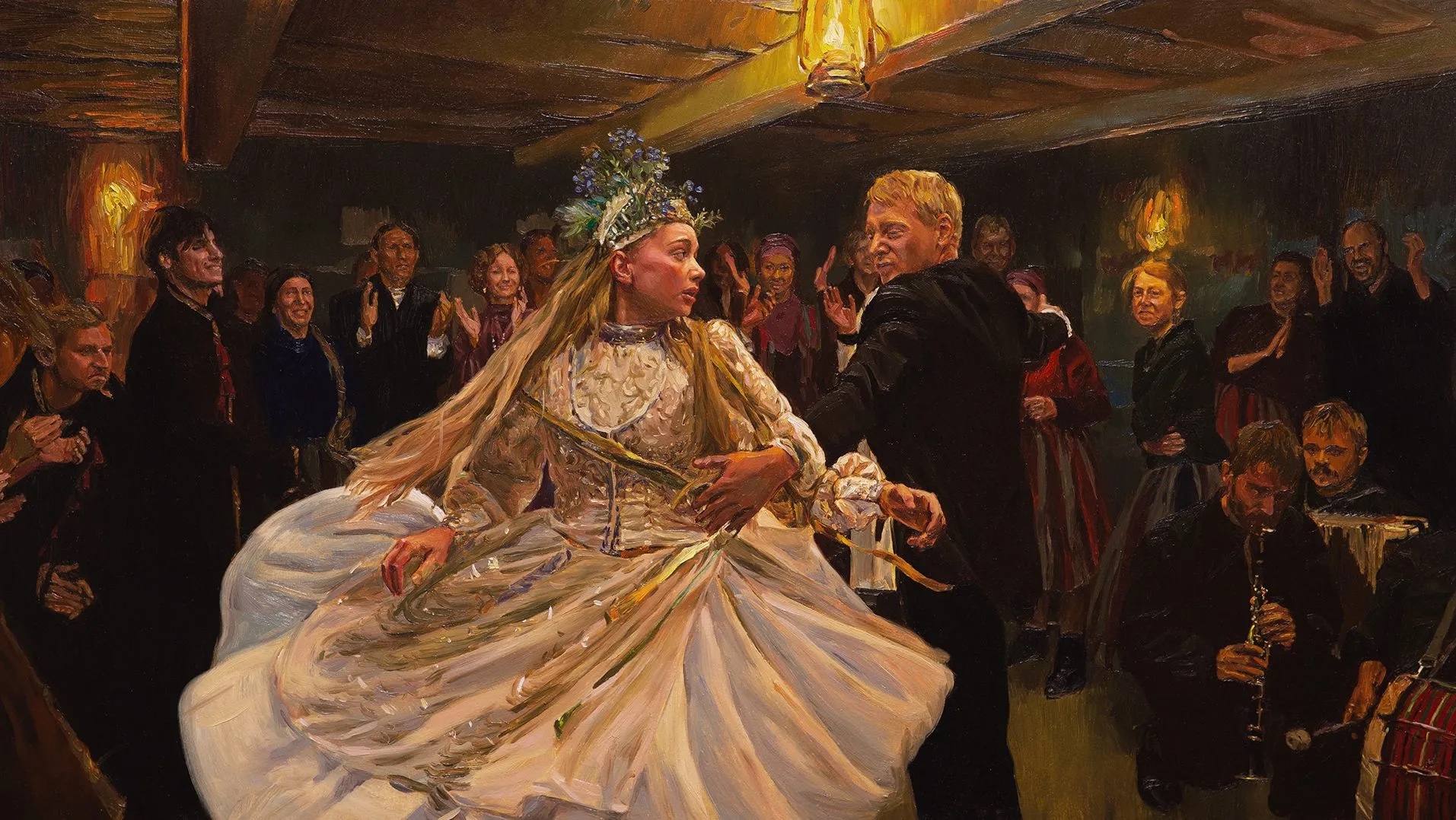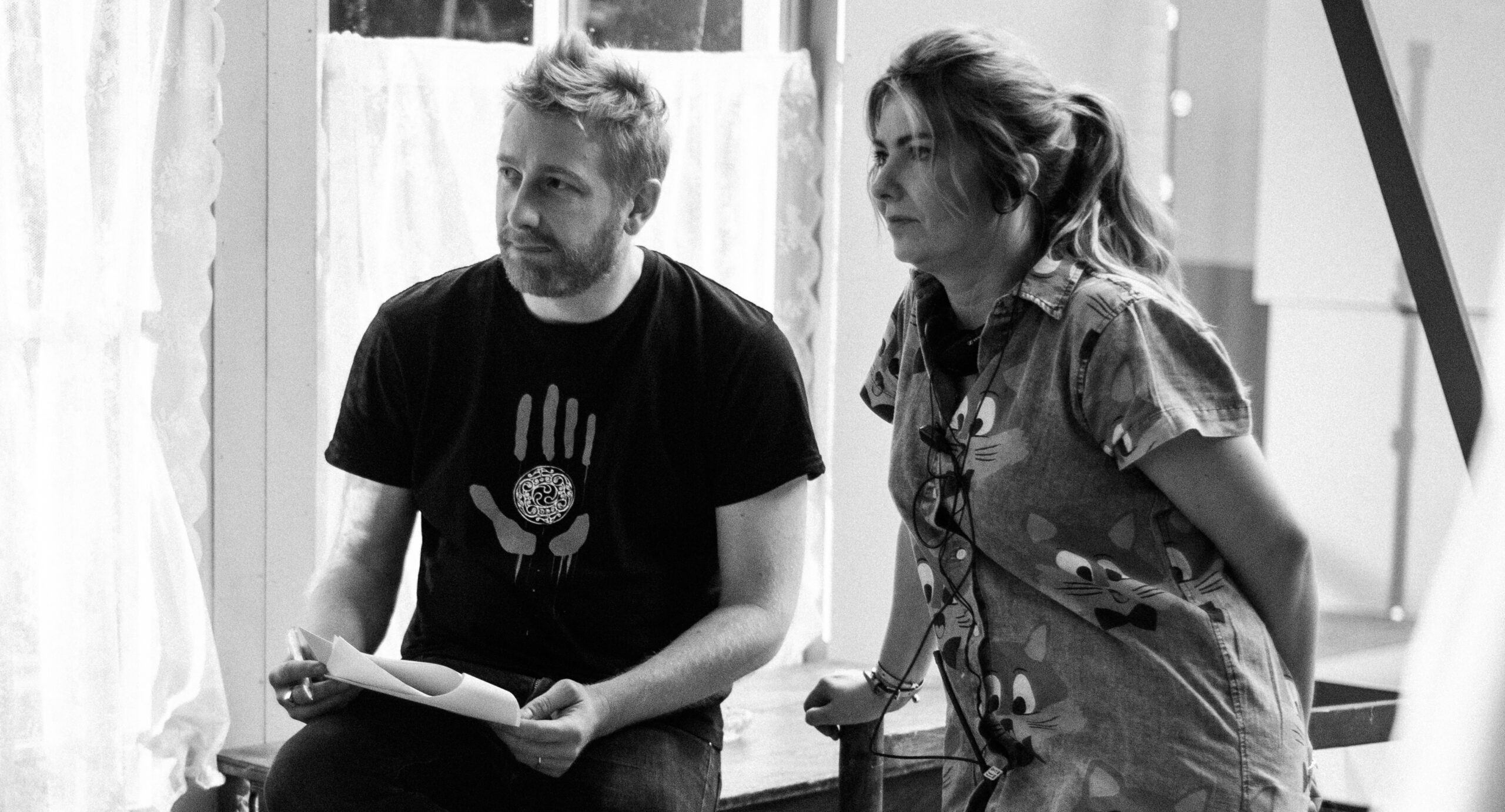interview
The six years that it took husband and wife filmmakers Hugh and Dorota Kobiela (DK) Welchman to release The Peasants were so arduous, it frequently looked like the film would never be completed. Even without a global pandemic, rising European inflation, and the outbreak of international war closing a studio and making many animators refugees, the Welchmans were ambitious in the scope of their follow-up to their Oscar-nominated animated drama Loving Vincent. The film is longer, the hand-painted animation style is much more complex, and their source text is a 1,000-page, Nobel prize-winning classic Polish novel.
As in Loving Vincent, Hugh and DK shot their adaptation of Władysław Reymont’s text in live-action, employing a fleet of artists to paint over in oils tens of thousands of frames. The rich colors of the animation combine with a robust, stirring story of prejudice and resentment in agrarian Poland, following the young, beautiful maiden Jagna (Kamila Urzedowska) at the center of a jealous farming feud between father Boryna (Miroslaw Baka) and son Antek (Robert Gulaczyk).
Ahead of the film’s release, Projektor spoke to Hugh Welchman, among other things, about adapting this story in his signature style, the merits of handmade work versus AI, and the unique struggle of making a film amid a global pandemic and warfare.

Projektor: Just as there are loads of different literary styles in Reymont’s novel, there are different painting influences in your film – and you’re also marrying animation with the language of live-action filmmaking. What was the process of building such a wide variety of visual influences?
Hugh Welchman: They came from many sources. Reymont was part of the Young Poland movement, which was poetry, novels, sculpture, painting… The Young Poland painters were a nice fit because it was the same aspirations of expressing Polish identity. But also that movement was on the tail end of European realism. That was important because it was the plein air era of painters, going out on the trains into the villages and recording rural life and making statements about the state of 19th-century modern life by doing so.
We could pick and choose the sky and trees as inspirations, which meant that the painting was serving the story, rather than the story serving the painting. Both Piotr [Dominiak, The Peasants’ art director] and DK did nine years of specialist [art] education. They could really access their education to define the style, which for them was exciting because they knew these paintings very well. These painters are not only almost unknown outside of Poland, but they’re not that well known in Poland either.
You focus more on the subjects of this school of painting rather than any artist. Was it liberating to come at art animation through a different lens from your previous film?
Absolutely. It was all about the story of Jagna, the quadrangle of passion and jealousy between her, Boryna, Antek, and Hanka [Antek’s wife, played by Sonia Mietielica]. When we first talked about it after I’d read it, we knew that that was going to be the core of the film and Jagna was the most fascinating character. We were like, this is Jagna’s film. The book is a year in the life of a community, and she’s one of the most important characters, but still, it’s a book of a whole community. It was wonderful to use all the possibilities of oil painting animation, to intensify, to beautify, to deepen the feelings around what was happening to Jagna. It’s not a gimmick. It’s a filmmaking tool to make the film better.
“It was wonderful to use all the possibilities of oil painting animation, to intensify, to beautify, to deepen the feelings around what was happening to Jagna. It’s not a gimmick. It’s a filmmaking tool to make the film better.”
Something you notice about watching painted animation is a heightened awareness of light because it’s all been constructed with colors and dyes. Were there methods of shooting the live-action footage that would aid you in the painting process?
We talked a lot about how we could make it look painterly when we were lighting and shooting it. But, and I think this was necessary, it always took a backseat to how we were going to convey the emotional heart of the scene. We started out like, “Oh, it’s much harder to paint a moving camera, so we’ll have this very classical locked-down camera to observe this.” But this story is about emotions boiling under the surface in front of you, in a very intimate setting. We have a big battle, but it’s a hand-to-hand battle between the village and the local squire. We have these fights that explode, but they’re in confined settings inside buildings. We have these dances, which are expressing emotions that can’t be vocalized.
We needed the camera to be right over the shoulder, right inside the dance, right inside the battle, and so we used a lot of moving cameras, a lot of Steadicam, a lot of handheld. It felt necessary to get in close to these heightened emotions and intense conflicts. Reymont captured the intimate cycle of human life, and when we were shooting it felt like we needed to be intimate.
People can now extend the frames of classical paintings with AI, which removes the composition and intent of the artist. In contrast to your film, we’re exclusively seeing intent – every image has had a human artist apply intent and craft to the emotion.
Each one of those frames is pretty much a day in the life of an oil painter who’s extraordinarily gifted and experienced. This was not only twice as long for every frame as compared to Loving Vincent, but we needed a whole different level of oil paint painter. On Loving Vincent, we had people from quite different backgrounds. For this, we needed people who were exceptional oil painting animators. For them to do a second of what you see before your eyes, we’re talking about a week of work.
Vincent wanted to express how he felt, so he developed a way of painting which was very quick to do. It was bold strokes, not as much mixing of colors. Whereas with realism, you can have up to 20 different colors in the cheek, and if you’re moving that cheek, then you have to move all of those colors. All painting requires simplification of reality, of course, but the painters in this are making subtler simplifications of reality.

This production was interrupted not just by the pandemic but by international war. Could you talk specifically about the dangers faced by international artists and how you sought to resolve them?
Well, with COVID we had to shut down the live-action shoot twice, the second time for a year. In terms of recruiting painters, we had people from 21 countries come and join us in Poland. People couldn’t travel – not only that, but people were loath to take the risk of traveling from the other side of Poland. All of a sudden, everything became more uncertain, people who would get on a plane were suddenly worrying about their rent and their livelihood in ways that they hadn’t five years before. Unlike other kinds of animation, we had to have people physically in our building at a painting animation workstation. We can’t do it remotely, we have a particular setup that requires people to physically be sitting in front of canvases with supervisors who are coming in to check on their painting and check on their color combinations. The inflation, which was an average of 20% in the countries we were making the film, caused havoc with the cost of living for our painters and the [production] costs.
And then the invasion of Ukraine really almost brought down the film. We had just set up two months before the Russian invasion with the studio in Kyiv, which we were very excited about because we had lots of great Ukrainian painters on Loving Vincent, so it made sense that they could stay in Ukraine with their families, rather than having to emigrate for the duration of the production. But then, of course, there was the invasion.

The Welchmans during the production of Loving Vincent, released in 2017. Photo: Loving Vincent / Hugh and DK Welchman.
We had to close the studio. We got everyone out that we could, we met at the border with all the women, some came with children and elderly mothers. We had to find accommodation, schools for their children, they became a very important part of our studio in Poland. But none of the men could leave, so the men were like, “Well, like there’s no jobs for painters in war-torn Ukraine. Are you guys going to open the studio?” And we felt that we wanted to open the studio, quite honestly, we felt that was still the best thing we could do to support them. So after four months, we reopened it. Then we were plagued by blackouts. Even though this is a $6.5 million film, part of our money just disappeared with the outbreak of war. So, from month to month, we struggle just to get enough money to pay the wages. We never had enough money to buy a big generator. Even though we had a budget of $6.5 million, we didn’t have 50,000 euros, so we ended up selling some Loving Vincent paintings and doing a Kickstarter to raise enough money to buy a generator which we then shipped from Germany to Ukraine. I think it was 10 months after the outbreak of war when we finally had a stable studio in Kyiv.
Also, a third of our painters in Poland in our Sopot, our main studio, were Ukrainian refugees. They were really important, not just because they’re amazing painters, but they were really big mood shifts. Because everyone was depressed at the uncertainties of life and then these people are coming and going, “Wow, let’s paint! We’ve got jobs! This is incredible, we can send money home to our family, and this is such a great opportunity for us.” So they were so positive when they had just come with a rucksack. Surprisingly, the refugees brought sunshine and positivity to us, the struggles we were having were put in context by the struggles that they and their families were having.
It allowed us to really refocus our energies on how exceptional what we were doing was, rather than looking backward and comparing to how things were on Loving Vincent or how things were before. We could really focus on how wonderful this opportunity was and grasp it.
Quite honestly, the outbreak of the war destabilized us so much that pretty much one out of [every] two months for the last year and a half of the project, I was not sure if we were going to make it through to the next month. This uncertainty and financial instability just hung over the whole thing until the end. It was three times harder to make than Loving Vincent, and that was hard when we were making it.
Curated by humans, not algorithms.
© 2024 A Good Movie to Watch. Altona Studio, LLC, all rights reserved.